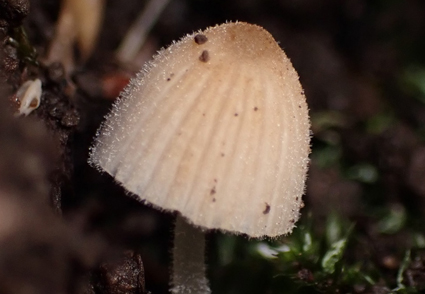Abstract
A new species of Cremastra (Orchidaceae), C. saprophytica, is described from Gifu Prefecture, Japan. The new species is similar to C. aphylla in having a leafless and mycoheterotrophic habit. However, it is distinguishable from C. aphylla by its green stem, more closed perianth tube, smaller lateral lobes of lip, smaller callus of lip positioned at base of the midlobe and absence of a rostellum and viscidium. An illustration and ecological information on the new species are provided. A key to the Cremastra species is also provided.
References
Chase, M.W., Cameron, K.M., Freudenstein, J.V., Pridgeon, A.M., Salazar, G., Van den Berg, C. & Schuiteman, A. (2015) An updated classification of Orchidaceae. Botanical Journal of the Linnean Society 177: 151–174. https://doi.org/10.1111/boj.12234
Chen, Q.H. & Chen, S.C. (2003) Additions to the orchid flora of Guizhou, China. Acta Phytotaxonomica Sinica 41: 263.
Chung, M.Y. & Chung, M.G. (2003) The breeding systems of Cremastra appendiculata and Cymbidium goeringii: high levels of annual fruit failure in two self-compatible orchids. Annales Botanici Fennici 40: 81–85.
Don, D. (1825) Prodromus florae Nepalensis. Gale, London, 256 pp.
Finet, M.E. (1896) III.—Note sur deux especes nouvelles d’ Oreorchis. Bulletin de la Societe Botanique de France 43: 697–698. https://doi.org/10.1080/00378941.1896.10830726
Finet, M.E. (1897) IV.—Sur le genre Oreorchis Lindley. Bulletin de la Societe Botanique de France 44: 69–74. https://doi.org/10.1080/00378941.1897.10830738
Freudenstein, J.V., Yukawa, T. & Luo, Y. (2017) A reanalysis of relationships among Calypsoinae (Orchidaceae: Epidendroideae): floral and vegetative evolution and the placement of Yoania. Systematic Botany 42: 17–25. https://doi.org/10.1600/036364417X694944
Hu, G.W., Long, C.L. & Motley, T.J. (2013) Cremastra malipoensis (Orchidaceae), a new species from Yunnan, China. Systematic Botany 38: 64–68. https://doi.org/10.1600/036364413X662033
Kobayashi, K., Suetsugu, K. & Wada, H. (2021) The leafless orchid Cymbidium macrorhizon performs photosynthesis in the pericarp during the fruiting season. Plant and Cell Physiology 62: 472–481. https://doi.org/10.1093/pcp/pcab006
Leake, J.R. (1994) The biology of myco-heterotrophic (‘saprophytic’) plants. New Phytologist 127: 171–216. https://doi.org/10.1111/j.1469-8137.1994.tb04272.x
Lindley, J. (1833) The genera and species of orchidaceous plants. Ridgeways, London.
Lund, I.D. (1988) The genus Cremastra (Orchidaceae), a taxonomic revision. Nordic Journal of Botany 8: 197–203. https://doi.org/10.1111/j.1756-1051.1988.tb00502.x
Makino, T. (1904) Observations on the flora of Japan. Botanical Magazine Tokyo 18: 14–24. https://doi.org/10.15281/jplantres1887.18.203_14
Martos, F., Dulormne, M., Pailler, T., Bonfante, P., Faccio, A., Fournel, J., Dubois, M.P. & Selosse, M.A. (2009) Independent recruitment of saprotrophic fungi as mycorrhizal partners by tropical achlorophyllous orchids. New Phytologist 184: 668–681. https://doi.org/10.1111/j.1469-8137.2009.02987.x
Suetsugu, K. (2013a) Autogamous fruit set in a mycoheterotrophic orchid Cyrtosia septentrionalis. Plant Systematics and Evolution 299: 481–486. https://doi.org/10.1007/s00606-012-0736-z
Suetsugu, K. (2013b) Delayed autonomous self-pollination in two Japanese varieties of Epipactis helleborine (Orchidaceae). Botanical Journal of the Linnean Society 173: 733–743. https://doi.org/10.1111/boj.12111
Suetsugu, K. (2015) Autonomous self-pollination and insect visitors in partially and fully mycoheterotrophic species of Cymbidium (Orchidaceae). Journal of Plant Research 128: 115–125. https://doi.org/10.1007/s10265-014-0669-4
Suetsugu, K., Haraguchi, T.F. & Tayasu, I. (2021) Novel mycorrhizal cheating in a green orchid: Cremastra appendiculata depends on carbon from deadwood through fungal associations. New Phytologist. https://doi.org/10.1111/nph.17313
Suetsugu, K., Matsubayashi, J. & Tayasu, I. (2020) Some mycoheterotrophic orchids depend on carbon from dead wood: novel evidence from a radiocarbon approach. New Phytologist 227: 1519–1529. https://doi.org/10.1111/nph.16409
Suetsugu, K., Ohta, T. & Tayasu, I. (2018) Partial mycoheterotrophy in the leafless orchid Cymbidium macrorhizon. American Journal of Botany 105: 1595–1600. https://doi.org/10.1002/ajb2.1142
Tremblay, R.L., Ackerman, J.D., Zimmerman, J.K. & Calvo, R.N. (2004) Variation in sexual reproduction in orchids and its evolutionary consequences: a spasmodic journey to diversification. Biological Journal of the Linnean Society 84: 1–54. https://doi.org/10.1111/j.1095-8312.2004.00400.x
Watthana, S., Fujikawa, K. & Kertsawang, K. (2015) First record of Cremastra Lindl.(Orchidaceae) in Myanmar. Acta Phytotaxonomica et Geobotanica 66: 197–200.
Yagame, T., Funabiki, E., Nagasawa, E., Fukiharu, T. & Iwase, K. (2013) Identification and symbiotic ability of Psathyrellaceae fungi isolated from a photosynthetic orchid, Cremastra appendiculata (Orchidaceae). American Journal of Botany 100: 1823–1830. https://doi.org/10.3732/ajb.1300099
Yukawa, T. (1999) Cremastra aphylla (Orchidaceae), a new mycoparasitic species from Japan. Annals of the Tsukuba Botanical Garden 18: 59–63.
Zhou, X., Lin, H., Fan, X.L. & Gao, J.Y. (2012) Autonomous self-pollination and insect visitation in a saprophytic orchid, Epipogium roseum (D.Don) Lindl. Australian Journal of Botany 60: 154–159. https://doi.org/10.1071/BT11265
Zimmer, K., Meyer, C. & Gebauer, G. (2008) The ectomycorrhizal specialist orchid Corallorhiza trifida is a partial myco-heterotroph. New Phytologist 178: 395–400. https://doi.org/10.1111/j.1469-8137.2007.02362.x


